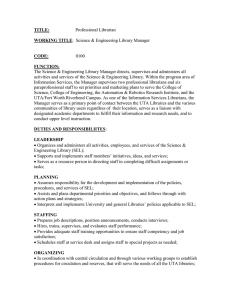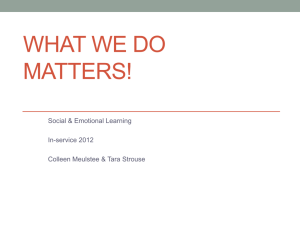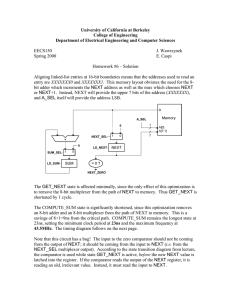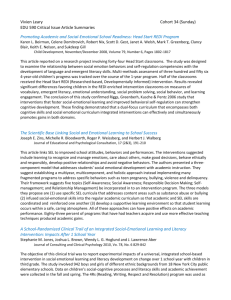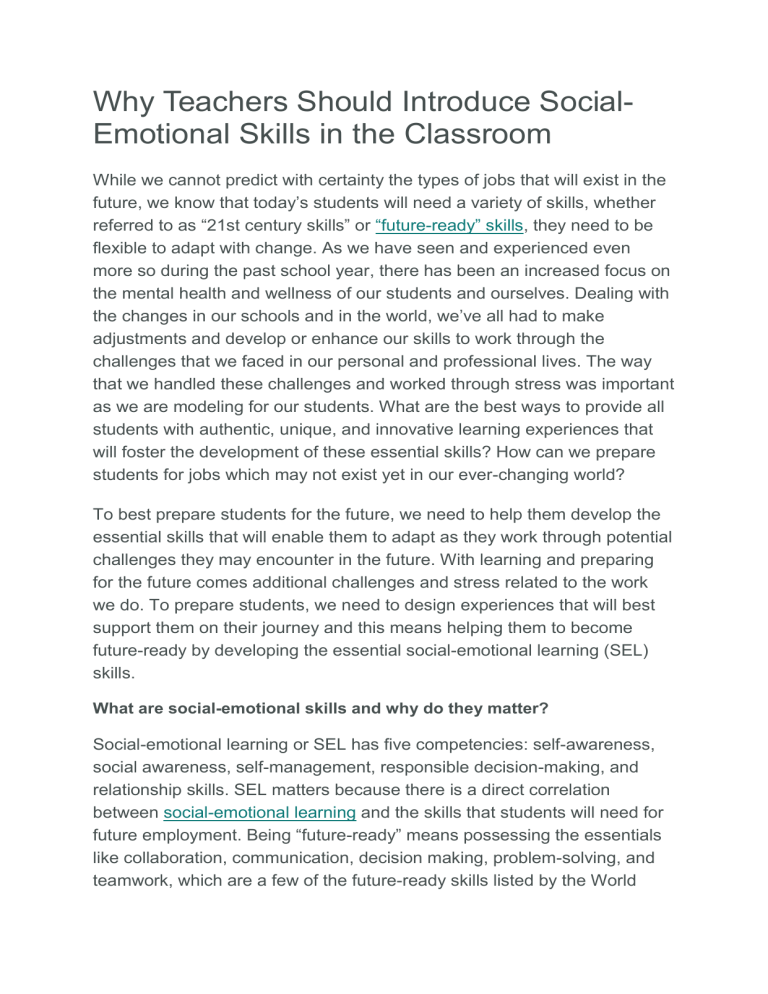
Why Teachers Should Introduce SocialEmotional Skills in the Classroom While we cannot predict with certainty the types of jobs that will exist in the future, we know that today’s students will need a variety of skills, whether referred to as “21st century skills” or “future-ready” skills, they need to be flexible to adapt with change. As we have seen and experienced even more so during the past school year, there has been an increased focus on the mental health and wellness of our students and ourselves. Dealing with the changes in our schools and in the world, we’ve all had to make adjustments and develop or enhance our skills to work through the challenges that we faced in our personal and professional lives. The way that we handled these challenges and worked through stress was important as we are modeling for our students. What are the best ways to provide all students with authentic, unique, and innovative learning experiences that will foster the development of these essential skills? How can we prepare students for jobs which may not exist yet in our ever-changing world? To best prepare students for the future, we need to help them develop the essential skills that will enable them to adapt as they work through potential challenges they may encounter in the future. With learning and preparing for the future comes additional challenges and stress related to the work we do. To prepare students, we need to design experiences that will best support them on their journey and this means helping them to become future-ready by developing the essential social-emotional learning (SEL) skills. What are social-emotional skills and why do they matter? Social-emotional learning or SEL has five competencies: self-awareness, social awareness, self-management, responsible decision-making, and relationship skills. SEL matters because there is a direct correlation between social-emotional learning and the skills that students will need for future employment. Being “future-ready” means possessing the essentials like collaboration, communication, decision making, problem-solving, and teamwork, which are a few of the future-ready skills listed by the World Economic Forum. Research shows that by regularly addressing the five competencies of SEL in our classrooms, we will positively impact and see an increase in student academic performance. To learn more about SEL, I recommend that educators check out the resources available from CASEL, the Collaborative for Academic, and Social and Emotional Learning. In our work, we need to promote the future readiness of our students and the five SEL competencies directly correlate to the social-emotional skills students need. The five competencies are: 1. Self-awareness: Being self-aware helps students to understand where they are during the learning process and identify their skills and interests as they continue to learn and evolve as learners. 2. Self-management: Students develop the skills to deal with any emotions or stress experienced during the learning process. In building selfmanagement skills, students focus on setting goals and dealing with any stress they experience. Through learning activities that are scaffolded or promote independent learning, students will see learning as a process, rather than a final product as they develop their own personalized work plan. Developing skills of self-management is essential for the future. 3. Social awareness: Students develop an understanding of others’ perspectives and different cultures. The development of compassion and empathy are important for students as they learn to interact with others and build interpersonal skills. 4. Relationship skills: As employers seek skills such as teamwork and leadership qualities, providing opportunities for students to build supportive relationships will help them to feel confident asking for help and working as part of a team. Developing relationship skills will best prepare students for future workplace success. 5. Decision making: Students develop critical thinking and problemsolving skills, learn to process information, and find solutions. By providing students with learning activities that promote higher-order thinking and collaboration, for example, we will empower students to make decisions about their own personal growth and develop social-emotional skills that will transfer to whatever they decide to do when they leave our classrooms. Bringing SEL to our classrooms Finding ways to bring SEL into our classrooms is not meant to be something extra or time-consuming. We have many ways to weave SEL activities into what we are already doing that will promote student engagement in learning and help students to develop the essential SEL skills to best prepare them for the future. 1. Digital tools. There are digital tools that can help educators to create spaces for students to build self-awareness and self-management. Using tools that promote reflection or check-ins are good options for helping students to gauge their understanding and check their progress in learning. 2. Digital portfolios. Creating evidence of learning is important for students. Using a digital portfolio is an option that can help students develop selfawareness and self-management as they reflect on their growth and set new goals for their learning journey. 3. Collaborative spaces. Using online collaborative spaces is beneficial for fostering a sense of community, in particular, useful for when students are learning from home rather than in the classroom and good preparation for future work. 4. STEM activities. With the variety of options available, STEM can promote the development of SEL and empower students with new ways to create, innovate, iterate and reflect, all of which help to develop SEL skills. EVERFI has a variety of programs and resources that can provide students with access to learning about STEM careers, business planning, and career readiness. 5. Inquiry methods. Methods such as project-based learning (PBL) promote the development of SEL and self-efficacy through a student-directed, independent learning experience. We want to promote student agency and PBL helps students to work through challenges, decide how to balance their work, and come up with their own workflow. PBL promotes critical thinking, creativity, problem-solving, and enhances the learning potential for each student as they design their own learning path. Students need more real-world experiences, where they can assess needs in their community and brainstorm ways to effect changes that will positively impact others beyond their classroom walls. Benefits of SEL for the Future With more social-emotional awareness, students will be better able to evaluate their skills and set goals for the steps they need to take in order to continue to grow as learners. As for long term benefits, competency in SEL positively impacts the future success of students whether in college or in the workplace. If we provide ways for students to more actively learn and explore the world, they will build skills in communication, collaboration, problem solving, resilience and others that employers seek. Students will have the right skills, real-world awareness, and flexibility that will best prepare them for a constantly evolving world and changing work environments. Rachelle Dené is a Spanish and STEAM: What’s nExT in Emerging Technology Teacher at Riverview High School in Oakmont, PA. Rachelle is also an attorney with a Juris Doctor degree from Duquesne University School of Law and a Master’s in Instructional Technology. Rachelle is an ISTE Certified Educator and serves as the past president of the ISTE Teacher Education Network. She was named one of 30 K-12 IT Influencers to follow in 2021. She is the author of six books including ‘In Other Words: Quotes That Push Our Thinking,” “Unconventional Ways to Thrive in EDU”, “The Future is Now: Looking Back to Move Ahead,” “Chart A New Course: A Guide to Teaching Essential Skills for Tomorrow’s World, “True Story: Lessons That One Kid Taught Us” and her newest book “Your World Language Classroom: Strategies for In-person and Digital Instruction” is now available. Follow Rachelle on Twitter @Rdene915 and on Instagram @Rdene915. Rachelle has a podcast, ThriveinEDU available at https://anchor.fm/rdene915

